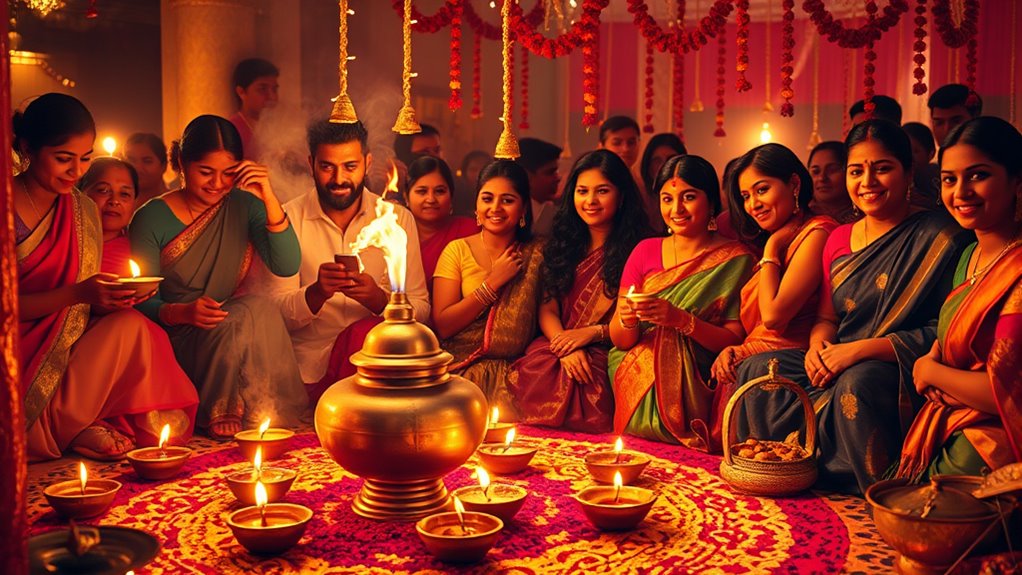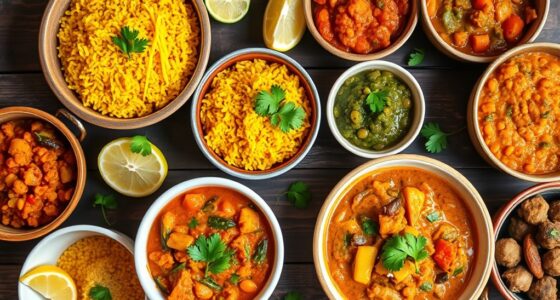During Diwali, you can embrace traditions like lighting oil lamps and fireworks to symbolize victory of light over darkness. You’ll participate in pujas, decorate your home with Rangoli, and wear colorful attire and jewelry that reflect cultural pride. Enjoy festive foods, especially sweets like ladoos and jalebi, that symbolize prosperity. Sharing gifts and sweets with family and community strengthens bonds. To explore more about the rich rituals and foods, keep going—you’ll discover even more ways this candlelit festival brings people together.
Key Takeaways
- Diwali rituals include lighting oil lamps, performing Lakshmi and Ganesha pujas, and creating Rangoli designs to invite prosperity.
- Traditional foods feature sweets like ladoos, jalebi, and savory snacks such as mathri and chakli, symbolizing abundance and joy.
- Decorations with diyas, fireworks, and floral motifs celebrate victory of light over darkness and mythological stories.
- Cultural attire, jewelry, and regional customs enhance festive spirit and showcase diverse celebrations across India.
- Sharing sweets, gifts, and participating in community events strengthen social bonds and reinforce the spirit of generosity.
The Historical Roots of Diwali Celebrations
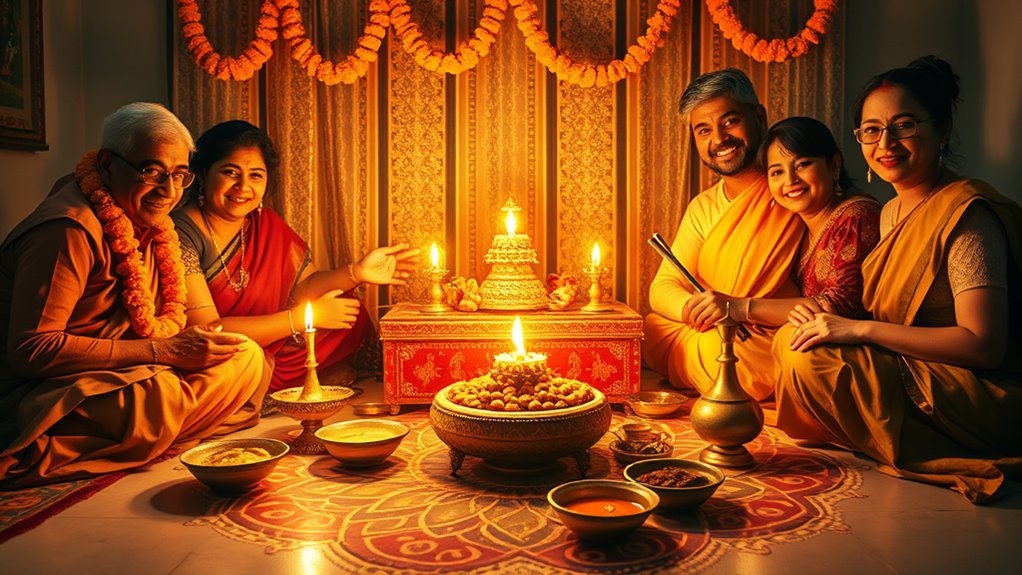
Diwali, also known as the Festival of Lights, has deep historical roots that trace back thousands of years. The Diwali historical origins are linked to ancient festival roots that celebrated the victory of good over evil. In early times, it marked the end of the harvest season and was a time to honor deities like Lakshmi and Lord Rama. Many traditions stem from these ancient origins, reflecting stories of mythological significance. The festival’s roots are embedded in diverse cultural and religious practices across India, making it a celebration of prosperity, renewal, and triumph. Understanding these historical foundations helps you appreciate the rich cultural heritage behind Diwali, which has persisted through centuries and continues to be a vibrant part of millions of lives today. Seed allergies and sensitivities are also part of this complex historical and cultural tapestry, reminding us of the importance of health awareness in traditional celebrations.
Significance of Lighting Lamps and Diyas
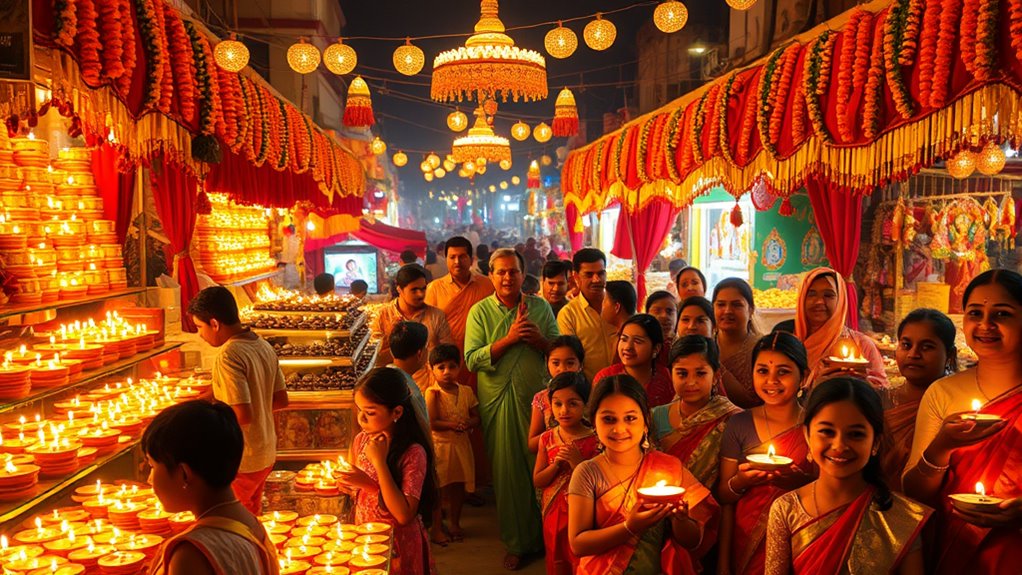
Have you ever wondered why lighting lamps and diyas is such a central part of Diwali celebrations? It symbolizes the victory of light over darkness and ignorance. The warm glow of diyas guides positive energy into your home and community, creating a festive atmosphere. The craftsmanship of diyas adds cultural value, showcasing intricate designs and traditional techniques passed down through generations. Each lamp’s symbolism reminds you of inner enlightenment and spiritual growth. Here’s a quick look at the significance:
| Lamp Symbolism | Diyas Craftsmanship | Cultural Meaning |
|---|---|---|
| Light over darkness | Hand-painted designs | Unity and prosperity |
| Inner enlightenment | Decorative patterns | Hope for new beginnings |
| Spiritual awakening | Unique craftsmanship | Joy and celebration |
Lighting diyas connects you to tradition and your inner self. Embracing creativity in the decoration and arrangement of diyas can further enhance the festive mood and express cultural uniqueness.
Rituals and Puja Ceremonies During Diwali
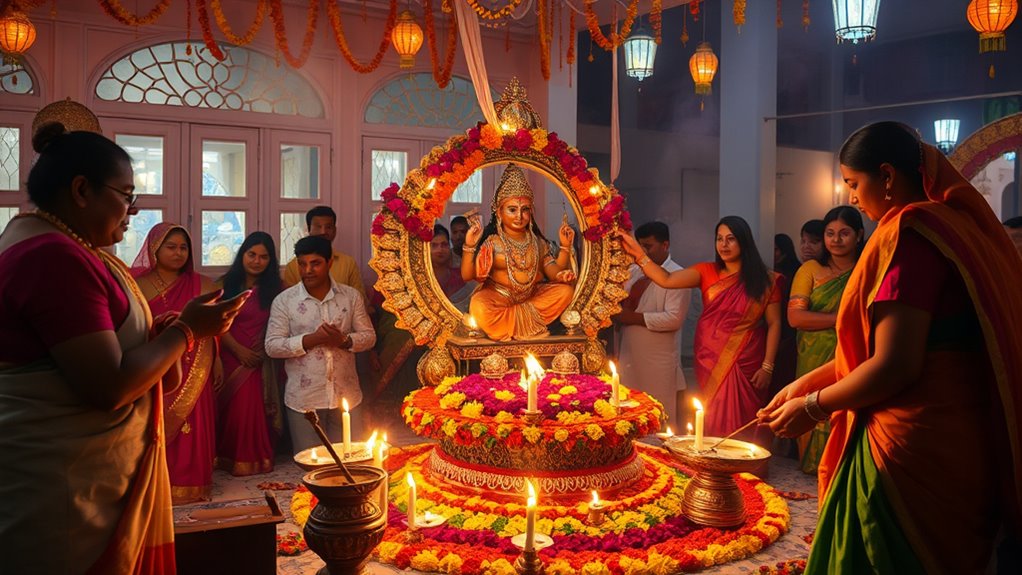
During Diwali, you participate in rituals and puja ceremonies that hold deep spiritual meaning. You’ll follow specific steps to honor deities and invite prosperity, using traditional offerings and symbols. These practices connect you to centuries-old traditions that celebrate light, wealth, and new beginnings. Incorporating traditional offerings enhances the spiritual significance of the ceremonies and aligns with established customs.
Ritual Significance and Steps
The rituals and puja ceremonies performed during Diwali hold deep symbolic significance, representing the victory of light over darkness and good over evil. You start by cleaning and decorating your home, often hanging Diwali lanterns to symbolize enlightenment. Light oil lamps and candles to illuminate every corner, creating a welcoming atmosphere. As part of the ritual steps, you perform a puja dedicated to Lakshmi and Ganesha, praying for prosperity and wisdom. Fireworks displays are also integral, symbolizing the eradication of evil and the celebration of triumph. The vibrant lights and bursts of color reinforce the spiritual victory, awakening your inner light and inspiring hope. Incorporating color accuracy in your decorations and lighting can enhance the visual beauty of the celebration. These acts foster a sense of unity, devotion, and renewal during this festive season.
Puja Offerings and Symbols
Puja offerings during Diwali are carefully chosen to honor the deities Lakshmi and Ganesha, whose blessings are sought for prosperity and wisdom. You place ritual offerings such as flowers, sweets, and incense before the idols or images, symbolizing devotion and gratitude. Decorative symbols like lamps, diyas, and rangoli patterns enhance the spiritual atmosphere, representing light overcoming darkness. These symbols serve as visual reminders of inner purity and the divine presence. During the puja, you arrange specific ritual offerings that align with tradition, each holding symbolic meaning. The act of offering these items connects you to the spiritual energy of the festival, inviting blessings and positive energy into your home. Creating a sacred space through these rituals is essential for meaningful worship and reflection. The combination of ritual offerings and decorative symbols creates a sacred space for worship and reflection.
The Role of Rangoli in Festive Decor

Rangoli plays an essential role in festive decor by transforming ordinary spaces into vibrant celebrations. You create intricate designs using colorful powders, rice, flower petals, or chalk, which instantly brighten the environment. These patterns often feature traditional motifs and symbols that carry cultural symbolism, representing prosperity, good luck, and spiritual harmony. As you craft each design, you participate in a centuries-old tradition that welcomes Lakshmi, the goddess of wealth, into your home. The visual appeal of rangoli enhances the festive atmosphere, making the entrance inviting and joyful. Its placement at doorways and courtyards signifies the importance of welcoming positive energy. Additionally, materials used for rangoli, such as vibrant powders and flower petals, are chosen for their auspicious significance. Ultimately, rangoli acts as a beautiful expression of cultural heritage, uniting families and communities in shared celebration.
Traditional Dress and Attire for the Festival
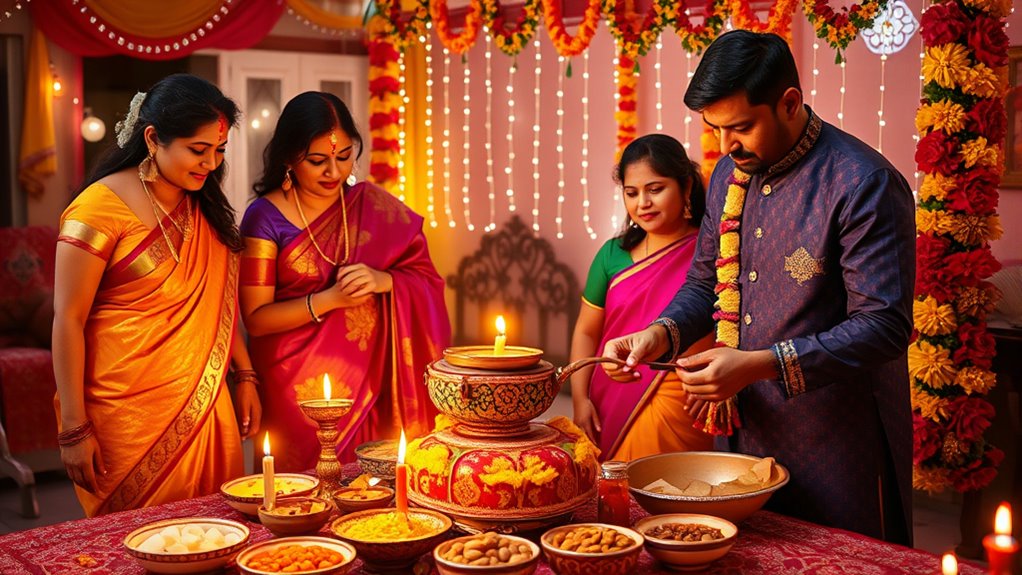
During festivals, traditional sarees and kurtas let you express cultural pride and add vibrancy to the celebrations. You’ll also notice colorful jewelry and accessories that enhance your overall look and symbolize festivity. Don’t forget to choose comfortable, stylish footwear that complements your attire and keeps you on your feet all day. Incorporating branding and marketing strategies into your festival attire can also boost your confidence and presence during celebrations.
Traditional Sarees and Kurtas
Traditional sarees and kurtas play an essential role in celebrating the festival, symbolizing cultural heritage and festive spirit. When you wear a saree, you’ll appreciate the art of saree draping, which varies by region and adds a touch of elegance. For men, kurta styles range from simple cotton designs to ornate embroidered versions, reflecting both tradition and personal taste. Choosing the right draping method or kurta style enhances your festive look and connects you to centuries of tradition. During Diwali, these garments aren’t just clothing—they embody the joy and cultural pride of the celebration. By wearing traditional attire, you honor your roots and embrace the festive atmosphere with confidence and grace. Additionally, incorporating traditional textiles such as silk or cotton can enhance the authenticity and comfort of your outfit, aligning with the cultural significance of self watering plant pots and other traditional elements.
Colorful Jewelry and Accessories
Complementing your elegant sarees and kurtas, colorful jewelry and accessories bring vibrancy and personality to your festive look. The jewelry craftsmanship shines through intricate designs that highlight traditional motifs, making each piece unique. You can choose from various accessory styles to suit your taste:
- Statement earrings that add sparkle and draw attention to your face
- Bold bangles and bracelets that complement your wrist movements
- Layered necklaces with traditional or contemporary designs
- Decorative hair accessories that enhance your overall appearance
These jewelry pieces and accessories complete your festive attire, reflecting the rich cultural heritage of Diwali. By selecting the right combination, you showcase your personality and celebrate the joyful spirit of the festival. Incorporating traditional motifs into your jewelry design can further emphasize the cultural significance of the occasion.
Festive Footwear Choices
Choosing the right footwear elevates your festive look and guarantees you stay comfortable throughout the celebrations. Traditional footwear, like juttis, mojris, or kolhapuris, perfectly complements your festive attire and adds an authentic touch. When selecting festival footwear, prioritize comfort without sacrificing style, as you’ll be on your feet for long hours. Brightly embroidered or embellished traditional footwear enhances the overall elegance of your outfit and reflects cultural heritage. Opt for shoes that match your dress, whether it’s a saree, lehenga, or kurta, to create a cohesive look. Remember, festival footwear isn’t just about appearance—it’s about blending style with practicality. Choosing the right pair ensures you enjoy the festivities without discomfort, making your celebration memorable and stylish. Incorporating authentic footwear that aligns with traditional designs can also deepen the cultural significance of your festive ensemble.
Regional Variations in Diwali Customs
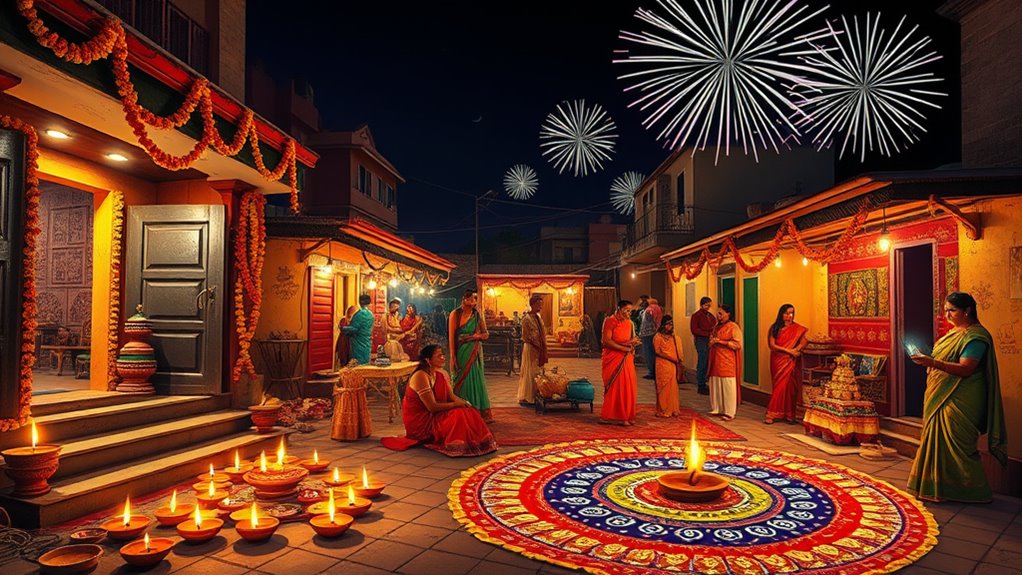
Diwali customs vary markedly across different regions, reflecting local cultures, beliefs, and practices. You’ll notice how traditions adapt to regional cuisine and local rituals, creating unique celebrations.
- In North India, lighting oil lamps and performing Lakshmi Puja is central, often accompanied by sweets like ladoos.
- South Indian regions emphasize elaborate firework displays and decorating with mango leaves, with unique regional dishes like murukku.
- In Bengal, Kali Puja replaces Lakshmi worship, with vibrant rituals and offerings to the goddess Kali.
- Western India, especially Gujarat, features colorful rangoli designs and festive fairs, blending local rituals with traditional foods like fafda and jalebi.
These regional variations highlight the diverse ways Diwali is celebrated, rooted in local customs and regional cuisine.
Popular Festive Foods and Their Cultural Meanings
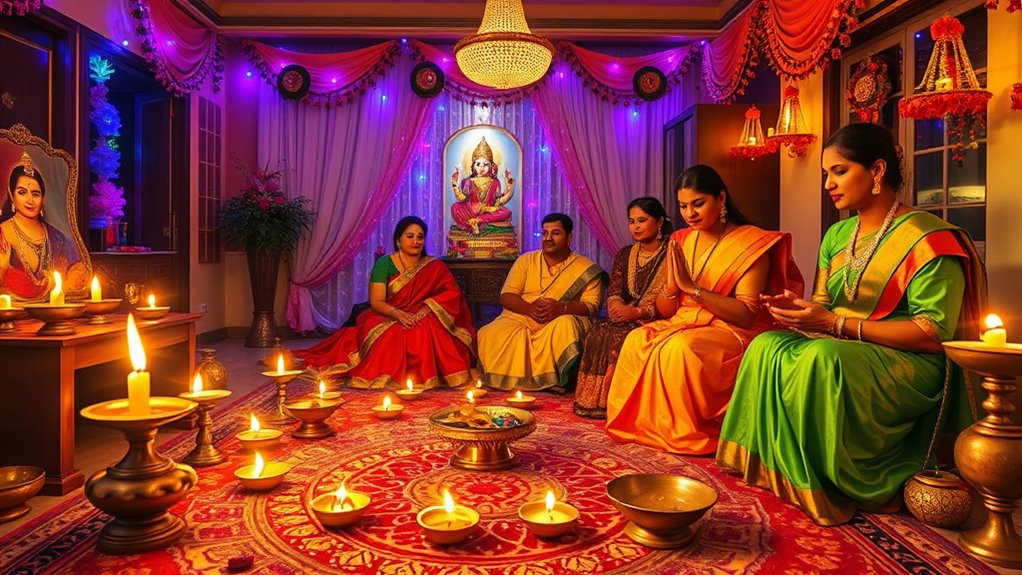
During festivals, the foods you enjoy often carry deep cultural meanings, from sweet treats to savory snacks. These dishes symbolize prosperity, unity, or tradition, enriching the celebration. Exploring their significance reveals how food connects us to our heritage and shared values.
Sweet Delights and Significance
Sweet treats often take center stage during festive celebrations, symbolizing joy, prosperity, and community bonding. During Diwali, these delights hold deep cultural significance. For example:
- Ladoo represents unity and good luck, often prepared during Diwali fire rituals.
- Jalebi symbolizes sweetness in life and is enjoyed during Diwali music celebrations.
- Kheer signifies prosperity and is shared among families to mark abundance.
- Barfi embodies happiness and togetherness, often exchanged as gifts.
These sweets aren’t just delicious—they reinforce bonds and cultural values. As you indulge, remember that their significance extends beyond taste, connecting you to centuries-old traditions like Diwali fire rituals and vibrant music celebrations.
Savory Snacks and Traditions
Savory snacks play an essential role in festive celebrations, offering a savory contrast to sweet treats and reinforcing cultural traditions. During Diwali, you might enjoy dishes like mathri, samosas, or namak pare, which symbolize prosperity and hospitality. These snacks often accompany Diwali fireworks displays and are prepared during Diwali cleaning, highlighting the importance of purification and renewal.
| Snack Type | Cultural Significance | Popular Variations |
|---|---|---|
| Mathri | Symbolizes prosperity and hospitality | Spiced, plain, or stuffed |
| Samosas | Represents unity and abundance | Vegetable or meat fillings |
| Namak Pare | Signifies purity and tradition | Salty, crispy varieties |
| Chakli | Brings good luck and festivity | Spiced, twisted shapes |
Festive Beverages and Symbolism
Festive beverages hold a special place in celebrations because they symbolize unity, prosperity, and spiritual renewal. These symbolic drinks often carry cultural meanings, connecting traditions to spiritual beliefs. During festivals, you might enjoy drinks that represent good luck and abundance.
Some common festive beverages include:
- Kesar Milk – symbolizes purity and prosperity.
- Jaljeera – a invigorating drink believed to aid digestion and bring harmony.
- Bhang – associated with spiritual bliss and divine connection.
- Thandai – signifies abundance and is often linked to festival joy.
Sweets and Snacks That Define Diwali
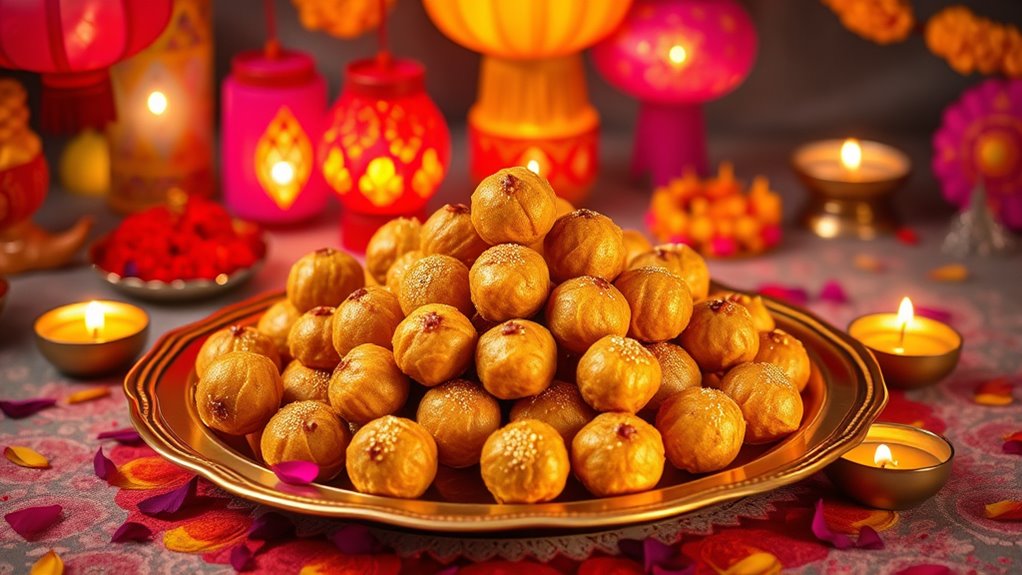
During Diwali, families come together to prepare and enjoy a variety of traditional treats that symbolize prosperity and joy. The most iconic diwali sweets include ladoos, barfis, and jalebis, which are enjoyed by everyone. These diwali sweets are often made with ingredients like milk, sugar, and nuts, highlighting their rich flavors. Alongside these, diwali snacks such as namak pare, mathri, and sev add crunch and savory balance to the festive spread. You’ll find that the preparation of these treats is a cherished part of the celebration, bringing families closer. Sharing diwali sweets and snacks not only satisfies your taste buds but also reinforces the spirit of togetherness and abundance that Diwali embodies.
Gift-Giving and Sharing Traditions
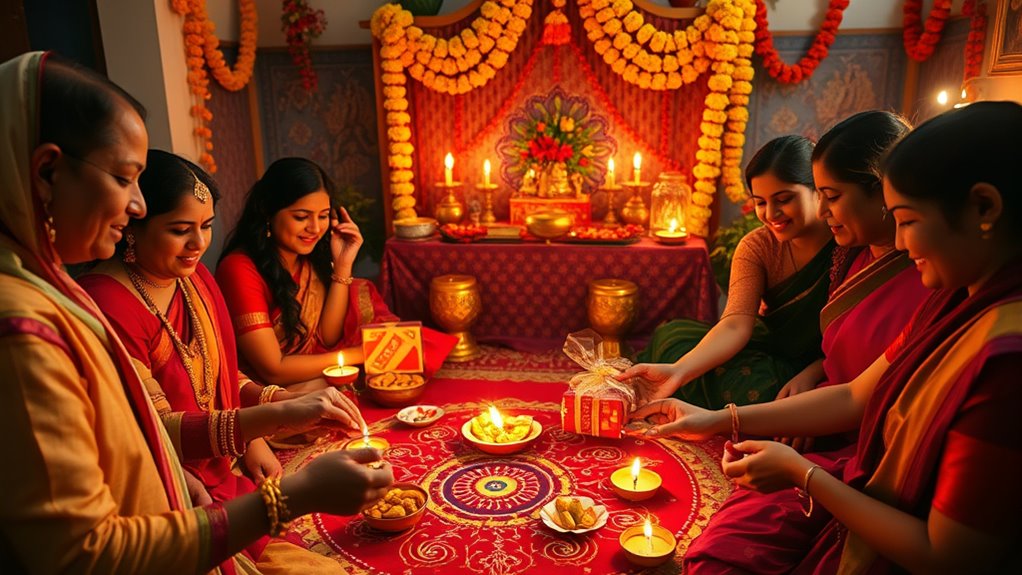
As families gather to prepare and enjoy traditional sweets and snacks, they also engage in meaningful gift-giving and sharing practices that deepen the spirit of Diwali. You might choose eco-friendly gifts like reusable decor or handcrafted items to show thoughtfulness and respect for the environment. Community sharing plays a crucial role, where you exchange gifts with neighbors and friends, fostering unity. Consider these ideas:
- Giving eco-friendly gifts to promote sustainability
- Sharing homemade treats to strengthen bonds
- Exchanging small, thoughtful presents with loved ones
- Participating in community sharing initiatives to support those in need
These traditions emphasize generosity, kindness, and social harmony, making Diwali a truly heartfelt celebration.
Modern Celebrations and Evolving Practices
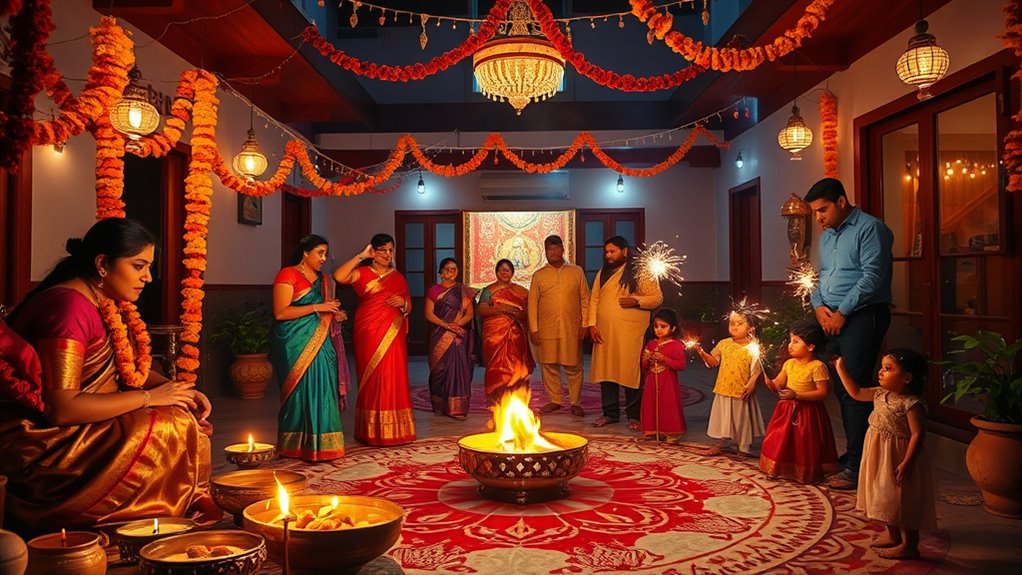
Modern celebrations of Diwali blend traditional customs with contemporary practices, reflecting how communities adapt to changing times. You might now enjoy eco-friendly decorations, such as recycled paper lanterns or biodegradable lights, to celebrate sustainably. Virtual celebrations have also become popular, allowing friends and family to connect regardless of distance. These evolutions help preserve the festival’s spirit while embracing modern values.
| Traditional Practices | Modern Adaptations |
|---|---|
| Lighting diyas | Eco-friendly decorations |
| Pujas and rituals | Virtual celebrations |
| Sharing sweets and gifts | Digital gifting options |
| Community gatherings | Online cultural programs |
| Decorative Rangoli | Eco-conscious art supplies |
Frequently Asked Questions
How Do Diwali Customs Differ Across Various Indian States?
You’ll notice that Diwali customs differ across Indian states due to regional variations and ritual adaptations. In some areas, people focus on Lakshmi Puja, while others emphasize Rama’s return or Kali worship. Food traditions also vary, with unique sweets and dishes. These differences reflect local cultures, traditions, and histories, making each state’s celebration special. You can experience diverse rituals that highlight India’s rich cultural tapestry during Diwali.
What Are the Environmental Impacts of Diwali Firecracker Use?
Did you know that Diwali firecracker use contributes markedly to air pollution and noise pollution? During the festival, firecrackers release harmful chemicals, increasing air pollution levels by up to 30%. This also causes noise pollution, disturbing wildlife and communities. You can enjoy the festivities responsibly by choosing eco-friendly fireworks or celebrating without firecrackers, helping reduce environmental harm and protect your community’s health during this vibrant festival.
How Has Diwali Celebration Evolved in Modern Urban Settings?
You see, Diwali celebrations in modern urban settings have evolved through urban adaptation and digital celebrations. You might now attend virtual fireworks shows, share online greetings, and participate in community events via social media. This shift allows you to celebrate safely in crowded cities, maintaining traditions while embracing technology. As a result, Diwali feels more connected and accessible, blending age-old customs with contemporary innovations.
What Are the Symbolic Meanings Behind Traditional Diwali Foods?
You’ll find that traditional Diwali foods are rich in symbolic ingredients and festive flavors, each representing good luck, prosperity, and purity. Sweets like ladoos and barfis symbolize sweetness in life, while savory snacks bring warmth and togetherness. These foods remind you of spiritual abundance and community, transforming simple ingredients into meaningful treats. By enjoying these, you’re celebrating cultural heritage and the joyful spirit of Diwali in every bite.
How Do Non-Hindu Communities Participate in Diwali Festivities?
You might be curious how non-Hindu communities participate in Diwali festivities. They often engage through interfaith participation, joining in celebrations like lighting lamps, sharing sweets, and attending cultural events. This fosters cultural fusion, allowing diverse groups to appreciate Diwali’s significance. Such involvement promotes unity, respect, and understanding, making the festival a shared experience beyond religious boundaries. Your participation helps strengthen community bonds and celebrates the rich diversity of traditions.
Conclusion
As you celebrate Diwali, remember it’s more than just lights and sweets—it’s a time to embrace tradition, share joy, and cherish togetherness. Will you take a moment to honor the rich history behind each ritual, or let the festivities pass by unnoticed? By understanding and participating in these customs, you keep the spirit of Diwali alive and vibrant, creating memories that last. So, why not make this festival truly meaningful for yourself and those around you?
